This project was a full user-centered design (UCD) research project.
The project was based on the poorer user experience smartphone users have bookmarking web pages, compared to the experience of users on desktop computers.
The author had created over a thousand bookmarks on his PC and Chromebook, but created very few on his smartphone.
Prior attempts to add and retrieve bookmarks using his mobile phone proved a poor user experience.
The decision to redesign the bookmarking process was based on a number of factors, including:
- The bookmarking redesign was a better match for the scope of the project.
- The prevalence of smartphone users who use their web browsers regularly, offered a much larger pool of research participants.
- Users are experienced at the process of bookmarking on personal computers, meaning user testing would require less induction.
